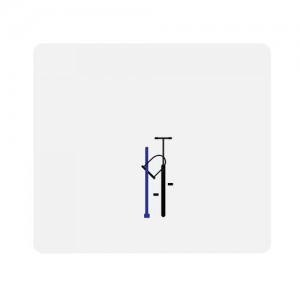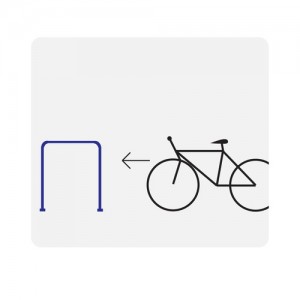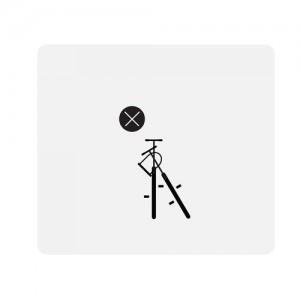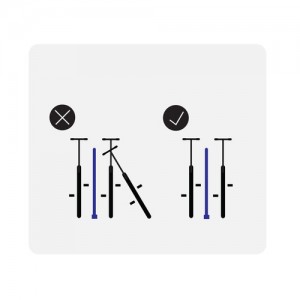Shop tip: locking your bike
By Patrick Loftus, Service Manager
 Properly locking your bike is the best way to keep it for a long time. Quality bike locks can be expensive, but they last for years and are much cheaper than buying a new bike. I recommend locking your bike at home, even if it is parked in a locked place. Most reports we hear of stolen bikes occur from porches, garages, yards, or because a cheap cable was cut. No lock is completely secure. Given enough time and the right tools, any lock can eventually be broken. The following will help you decide which lock is best for you and show you some techniques and etiquette to properly secure your bike.
Properly locking your bike is the best way to keep it for a long time. Quality bike locks can be expensive, but they last for years and are much cheaper than buying a new bike. I recommend locking your bike at home, even if it is parked in a locked place. Most reports we hear of stolen bikes occur from porches, garages, yards, or because a cheap cable was cut. No lock is completely secure. Given enough time and the right tools, any lock can eventually be broken. The following will help you decide which lock is best for you and show you some techniques and etiquette to properly secure your bike.
Types of locks from strongest to weakest:
U-locks – These are far and away the best, most secure option. Kryptonite locks are my favorite, but On Guard locks are also sturdy. U-style-locks from the big box stores are not nearly as secure as Kryptonite or On Guard. We carry three different grades of Kryptonite locks with a few different sizes in each grade. They range in price from $30-$75. Choose a model and size that best suits your locking needs. A smaller lock is harder to pry, while a large lock gives you more flexibility in what you are able to lock your bike to. If you’re frequently locking your bike on a campus, downtown (especially near the library), or overnight any place, get a u-lock.
Chain with a study padlock – A high quality chain is your next best option. They’re easier to cut than a u-lock, but still require a substantial tool to break. They’re good in situations where you want more flexibility than the u-lock provides or low risk situations. Use a chain if you primarily lock your bike in secure place (like a special bike room at your work) or for quick stops. Chains are also great if you store your bike on a porch, as they can fit around large wood railings. We carry a Kryptonite chain with a sturdy padlock for $30.
Cable locks – I don’t like cable locks, but they are better than nothing. They’re surprisingly easy to cut. Cables are best when used with a u-lock to provide a little more security for things like wheels or a trailer. We hear a lot of stories about cables being cut to steal bikes bikes, but very few accounts of cables being cut for just a wheel. Cable locks can be good for kids because they’re lighter to carry and kids’ bikes aren’t the main target of thieves. I use long cables to lock my bikes at home or with a u-lock to provide more security when I leave my bike at the airport. We stock Kryptonite cables with a built in lock for $18, with separate cables starting at $10, and separate padlocks starting at $6.
Acceptable places to lock your bike:
 Staple Racks – These are everywhere and the easiest to use. The city puts them on a lot of sidewalks and in clustered on-street corrals. Each staple is meant to lock two bikes, one on each side. For best results, park your bike head to toe with the other bike in the rack to avoid tangling handlebars. Make sure you don’t accidentally lock the bike next to you. Some staples are really close to curbside auto parking. Be careful parking too close to car doors or you might find a ding or chip on your bike.
Staple Racks – These are everywhere and the easiest to use. The city puts them on a lot of sidewalks and in clustered on-street corrals. Each staple is meant to lock two bikes, one on each side. For best results, park your bike head to toe with the other bike in the rack to avoid tangling handlebars. Make sure you don’t accidentally lock the bike next to you. Some staples are really close to curbside auto parking. Be careful parking too close to car doors or you might find a ding or chip on your bike.
Street signs – These are less secure than staple racks, but still work great. Any time I lock to a street sign I give it a wiggle to make sure it’s actually secured to the ground. Make sure the post has a sign on it or a thief could simply lift your bike over the pole. If you use a long cable or chain, avoid poles, as a thief could still lift your bike over the sign. Avoid parking meters! The city may impound your bike. If you do lock to a street sign, make sure your bike is not blocking store entrances or sidewalk access (especially ADA ramps).
Unacceptable places to lock your bike (seriously, don’t lock to these things. Check out City Ordinance 16.70.320 for Portland’s official operating rules):
Street trees – The city doesn’t allow this. Please don’t lock to trees.
Guard rails – If you lock to a guardrail, chances are you will partially block a ramp, staircase, or building entrance. Property owners don’t like this either. Please be courteous to others and find a bike rack.
Utility lines or pipes – Most gas, water, or electrical lines are considered private property and the owner may cut your lock and impound your bike if you block access to utilities. Don’t lock to utilities.
 Over another bike or wedged in tight next to one – The double parking of the bike world. Don’t lock your bike in a way that will prevent someone else from getting their bike out.
Over another bike or wedged in tight next to one – The double parking of the bike world. Don’t lock your bike in a way that will prevent someone else from getting their bike out.
Generally speaking you want to lock your bike in a well lit, high traffic area. Pick the light pole or staple rack in front of the busy restaurant over the pole around the corner on the quiet street.
Locking Techniques:
How you lock your bike is just as important as what kind of lock you use. Make sure you put the lock through the bike frame and to whatever you’re locking to. If you can get one or both wheels locked too, all the better. With just one average sized u-lock it is possible to lock both wheels and your frame to whatever you’re locking to. We’ll use u-locks to show the various techniques, but use these strategies for any lock.
No security – Front wheel only. The rest of the bike can be freed by just taking the wheel off.
Minimum security– Just the frame locked.
Better security– Get the frame and one wheel. If you lock the rear wheel inside the rear triangle you can’t separate the wheel and the frame. This means that even if the lock isn’t through the frame, you’re still locking both. This is a great way to maximize a small lock.
Maximum security – Take the front wheel off to lock both wheels and the frame to the bike rack. Or use a cable to lock both wheels and the frame. Be sure the sturdy lock goes around the frame. Note that if you loop the cable through itself, you can get a lot more length out of it.
Finals Thoughts:
 When you lock your bike, put the key entry side of the lock on the bike side, not the rack side. If someone locks to the other side of the rack or pole you will still be able to unlock your bike.
When you lock your bike, put the key entry side of the lock on the bike side, not the rack side. If someone locks to the other side of the rack or pole you will still be able to unlock your bike.
When locking your bike on a shared staple or pole, make sure you don’t lock the other bike by accident.
Consider swapping your quick-release skewers for a set that uses a wrench. Velo Orange makes security skewers that use a special hollow Allen wrench for $15. While skewers like these will make your wheels more secure, it’s still a good idea to lock your wheels.
As I mentioned above, any lock can be broken with the right tool and enough time. Think of locking your bike like running from a bear; you don’t have to be faster than the bear, just faster than anyone else also running from the bear. Likewise, when you lock your bike in a high risk area, you don’t necessarily need the most secure lock; you just need to be more secure than other bikes nearby with weaker locks.
If you’re still unsure about which type of lock is best for you, or if you just want to see what type of locks we carry, stop by our bike shop and speak to one of our friendly mechanics.
Illustrations by Britt Appleton